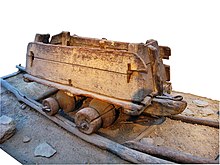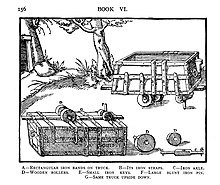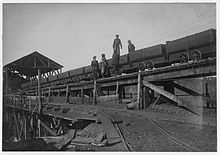Minecart
This article needs additional citations for verification. (July 2013) |

The minecart or mine cart (also known as a mine trolley) is a type of rolling stock found on a mine railway, used for moving ore and materials procured in the process of traditional mining. Minecarts are seldom used in modern operations, having largely been superseded in underground operations (especially coal mines) by more efficient belt conveyor systems that allow machines such as longwall shearers and continuous miners to operate at their full capacity, and above ground by large dumpers.
Design and operation
Shaped like large, rectangular buckets, minecarts ride on metal tracks and were originally pushed or pulled by men and animals (supplemented later by rope-haulage systems). As mines increased in size and output, the aforementioned methods became impractical because of the distances and quantities of material involved, so larger carts would be used, hauled by narrow gauge diesel and electric locomotives (in coal mining operations, where gas that is flammable would present a problem, the locomotives would be flameproof or battery powered). These were also used to pull trains transporting miners to the workfaces.
Minecarts range in size and usage, and are usually made of steel for hauling ore. Throughout the world, there are different titles for such carts. In South Africa, for instance, a minecart is referred to as a cocopan.[1] In Great Britain, restored mine carts (known as "tubs") containing floral displays can commonly be seen on village greens and outside pubs in former coal mining areas such as Northumberland and County Durham. Mine carts were a very important source of transportation of ore. In Wales, UK, minecarts are known as 'drams'
Minecarts were very important in the history of technology because they evolved into railroad cars. See History of rail transport.
-
Mining cart shown in De Re Metallica (1556). The guide pin fits in a groove between two wooden planks.
-
Child laborers on a minecart at Bessie Mine, Alabama, c. 1910-1911. Photo by Lewis Hine.
-
A mine car is weighed in a Kentucky coal tipple in 1946, before the coal is dumped into a railroad car.
Minecarts in popular culture
Minecarts have been depicted as a type of thrill ride; for instance Indiana Jones uses one in an escape scene. Similar minecart escape levels are common in video games, especially the Donkey Kong Country series. A minecart is also featured in Hoodwinked. In Sonic the Hedgehog 4: Episode I, Sonic rides a minecart in iOS/Android version of Lost Labyrinth Zone Act 2. Minecarts act as a mode of transport for players and items in Minecraft. There is also a character on the popular flash game Happy Wheels, known as the Explorer Guy, who rides a minecart. The main objective of the game, Rail Rush, from Miniclip for iOS is to ride on a mine cart for the longest possible distance while collecting gold nuggets and gems.
See also
References
- Periscope Film (2008). Mining Haulage: The Classic Mine Technology Book From 1907. Lulu.com. pp. 1–51. ISBN 098165262X. Retrieved December 2012.
{{cite book}}: Check date values in:|accessdate=(help); Cite has empty unknown parameter:|coauthors=(help) - Rakes, Paul H. (2012). "Coal Mine Mechanization." The West Virginia Encyclopedia. West Virginia Humanities Council, Charleston, WV.
External links
 Media related to Mining carts at Wikimedia Commons
Media related to Mining carts at Wikimedia Commons



